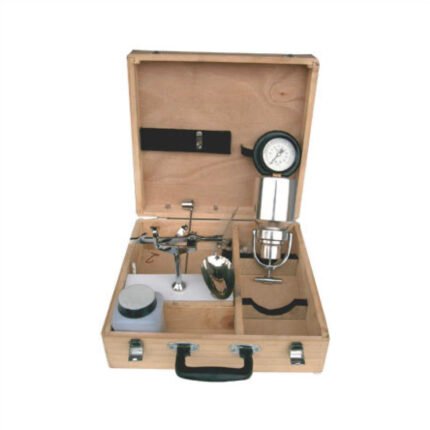AZA 0856 GRAIN SIZE ANALYSIS (PIPETTE METHOD)
- Grain size analysis using sedimentation and pipette method
- Ideal for determining particle distribution in fine soils
- Conforms to IS 2720 (Part 4) and ASTM D422
- Includes sedimentation cylinder, pipette, stand, timer
- Accurate and repeatable measurement of soil fractions
- Essential for geotechnical and soil mechanics labs
Description
The Grain Size Analysis (Pipette Method) apparatus is a precision testing setup used to determine the distribution of fine soil particles such as clay and silt. It is widely employed in geotechnical engineering, civil construction quality control, soil mechanics research, and academic laboratories. When standard sieve analysis becomes ineffective for particles smaller than 75 microns, the pipette method provides an accurate and detailed alternative based on sedimentation principles.
This is for the determination of the sub sieve particle distribution in a soil sample by mechanical analysis. An analysis of this kind
expresses quantity the proportions by weight of the various sizes of particles present in the soil. It is recommended as a standard procedure to use dispersion agent to avoid flocculation. The apparatus consists of a sliding panel which moves up and down by means of a screw allowing Anderson pipette fixed to it to be raised or lowered vertically. A sedimentation tube is held by a laboratory clamp provided on the stand below the pipette. The depth of immersion is measured by a scale graduated in mm at the side of the sliding panel. Supplied complete with Anderson pipette 10ml. At the side capacity made from glass, and a sedimentation tube also of glass of 500ml capacity and 50nos. Test form pads.
Accessories & Spares: (on extra cost)
1) Sedimentation Pipette (Anderson pipette) 25ml.
2) Sedimentation tube 100ml
3) Sedimentation pipette 10ml
4) Sedimentation tube 500ml
5) Test forms pad of 50
This method works by measuring the rate at which different-sized particles settle in a suspension. By using Stokes’ Law and timed extraction of samples at known depths, technicians can quantify the proportion of fine particles in soil samples. The method is particularly crucial for the classification of cohesive soils and for identifying the presence of expansive clay, silt, and colloidal content that can influence a structure’s performance. AZALAB
What’s Included in the Apparatus:
-
Sedimentation Cylinder (1-liter graduated glass cylinder): Where the soil-water suspension settles.
-
Pipette Assembly (usually 10 ml): For extracting samples from specific depths at set time intervals.
-
Stand with Pipette Holder: Ensures vertical positioning and repeatable sample collection.
-
Stopwatch or Timer: Essential for tracking sedimentation intervals.
-
Mechanical Stirrer or Mixing Rod: To uniformly disperse soil particles in water.
-
Thermometer: For adjusting readings based on water temperature, as viscosity affects particle settling.
All components are made of high-quality laboratory-grade materials that ensure long-term use, easy cleaning, and resistance to chemicals used in dispersing soil.
Working Principle:
The pipette method relies on the sedimentation of soil particles in a fluid medium (typically distilled water mixed with a dispersing agent like sodium hexametaphosphate). Once the uniform suspension is formed, the soil particles start to settle due to gravity. According to Stokes’ Law, larger particles settle faster than smaller ones.
At timed intervals, a pipette is used to extract small quantities of suspension from a predetermined depth. These samples are dried and weighed, and from the known total soil mass and cumulative sample weights, the distribution of particles finer than specific sizes is calculated. AZALAB+BIS
This method is suitable for particle sizes in the range of 0.002 mm to 0.075 mm.
Applications:
-
Geotechnical Investigation: Classify fine soils and assess their impact on foundation behavior.
-
Soil Classification Systems: Determine Atterberg Limits and other soil indices.
-
Academic Research & Education: Teach fundamental soil mechanics and sedimentation theory.
-
Construction & Earthworks: Evaluate soil suitability for roads, embankments, and backfills.
Standards Compliance:
-
IS: 2720 (Part IV) – Grain Size Analysis
-
ASTM D422 – Standard Test Method for Particle-Size Analysis of Soils
-
BS 1377 – Methods of test for soils for civil engineering purposes
Specifications Table:
| Component | Specification |
|---|---|
| Sedimentation Cylinder | 1000 ml, Borosilicate Glass, Graduated |
| Pipette Volume | 10 ml with 0.1 ml divisions |
| Stand Material | Mild Steel or Powder-Coated Aluminum |
| Dispersing Agent | Sodium Hexametaphosphate (not included) |
| Sampling Depth | Adjustable (commonly 10 cm below water level) |
| Timer | Digital or mechanical stopwatch |
| Temperature Compensation | Manual using thermometer |
Frequently Asked Questions (FAQs):
Q1: What is the purpose of the pipette method in grain size analysis?
A: It is used to determine the proportion of fine particles in soil, especially those smaller than 75 microns that can’t be captured by sieves.
Q2: What standards does this method comply with?
A: It complies with IS: 2720 (Part IV), ASTM D422, and BS 1377 standards for soil particle analysis.
Q3: Can I use this method for all types of soil?
A: It is most effective for fine-grained soils such as clays and silts. Coarser soils are best tested with sieve analysis.
Q4: Is the dispersing agent included in the kit?
A: No, chemical dispersants like sodium hexametaphosphate must be sourced separately.
Q5: How accurate is the pipette method?
A: When conducted properly, it provides highly accurate and repeatable results for fine soil particle distribution.
Additional information
| Pipette Volume |
10 ml with 0.1 ml divisions |
|---|---|
| Sedimentation Cylinder |
1000 ml, Borosilicate Glass, Graduated |
| Sampling Depth |
Adjustable (commonly 10 cm below water level) |
You may also like…
Abrasion Testing Machine for Glazed Tiles (AZA 1261)
Abrasion Testing Machine for Glazed Tiles (AZA 1262)
AZA 0786 CEMENT SAMPLER
AZA 0787 BLAINE’S AIR PERMEABILITY APPARATUS
IS 4031, 5516, 1727 & 4828, ASTM C-204, BS 4359-2
Specification: Designed to find out specific gravities of semi liquids like mud and other liquids having densities in the range 0.8 to 2.5. It has a stainless steel bam calibrated specific gravities from 0.8 to 2.5. A stainless-steel cup with lid and overflow vent is fitted on one side of the beam. A counter weight with cursor slides over the graduated scale. The beam has a knife-edge at center which rests in a fulcrum fitted in the stand. Leveling screws and spirit level are fitted to the stand.
Spares & Accessories (On Extra Cost):
Punch to cut filter paper discs. Non-perforated disc. Suction bulb, Mercury.
AZA 0788 VICAT NEEDLE APPARATUS WITH DASHPOT
AZA 0790 GILLMORE NEEDLE APPARATUS
Related products
AZA 0857 PARTICLE SIZE SEDIMENTATION (HYDROMETER METHOD)
- Particle size distribution using hydrometer sedimentation
- Suitable for clays and silts below 75 microns
- Conforms to IS 2720 Part IV & ASTM D422
- Includes hydrometer, sedimentation cylinder, thermometer
- Accurate readings of soil particle settlement over time
- Ideal for soil mechanics, civil and geotechnical labs
AZA 0859 SAND EQUIVALENT TEST SET
- Evaluates relative proportion of sand vs clay/silt in fine aggregates
- Complies with ASTM D2419 and IS 2720 standards
- Includes graduated cylinder, irrigator tube, siphon assembly
- Portable and easy to operate in field or lab
- Improves quality control in construction and roadwork
- Ideal for geotechnical and civil testing laboratories
- Optional : Stock solution can be supplied at an extra cost
AZA 0860 METHYLENE BLUE TEST SET
- Determines clay content in fines and aggregates
- Based on Methylene Blue Value (MBV) method
- Complies with ASTM C837 and EN 933-9 standards
- Includes digital burette, conical flask, filter paper, and stirrer
- High sensitivity to montmorillonite and other clays
- Ideal for geotechnical, concrete, and aggregate testing labs
AZA 0862 PLUMMET BALANCE
AZA 0870 VICKSBERG PENTROMETER (PROVING RING TYPE)
AZA 0874 RAPID MOISTURE METER
- Rapid Moisture Meter: Utilizes the calcium carbide method for quick determination of moisture content.
- Field-Ready: Ideal for field testing of soils, aggregates, sand, and fine materials.
- Portable & Self-Contained: No external power source required, perfect for on-site quality control.
- Immediate Results: Provides fast, accurate readings, enabling immediate adjustments.
- Durable Construction: Robust design suitable for demanding construction and geotechnical testing environments.
- Azalab Quality: Reliable and efficient tool for rapid soil moisture assessment.
AZA 0875 INFRARED MOISTURE METER
- Infrared Heating: Utilizes advanced infrared technology for rapid and uniform sample drying.
- Precise Measurement: Delivers highly accurate moisture content results in a fraction of the time.
- Versatile Application: Ideal for various materials including soils, aggregates, chemicals, food products, and more.
- User-Friendly: Features intuitive controls and a clear display for straightforward operation.
- Rapid Analysis: Significantly speeds up testing processes compared to conventional oven drying.
- Azalab Quality: Reliable and efficient instrument for critical quality control and material testing.
AZA 0876 PERMEABILITY APPARATUS (FALLING HEAD PERMEABILITY)
- Falling Head Test: Specifically designed for determining the permeability of fine-grained soils.
- Accurate Hydraulic Conductivity: Provides precise measurement of the coefficient of permeability.
- Complete System: Includes all necessary components for performing the falling head test.
- Durable Construction: Built for reliable performance in geotechnical laboratories.
- Standard Compliant: Adheres to relevant ASTM and other international standards.
- Azalab Quality: Ensures accuracy and dependability in soil permeability testing.

 Rock
Rock Aggregate
Aggregate Cement
Cement Concrete
Concrete Soil
Soil Steel
Steel Bitumen/Asphalt
Bitumen/Asphalt Security Survey Equipment
Security Survey Equipment General Items
General Items
















